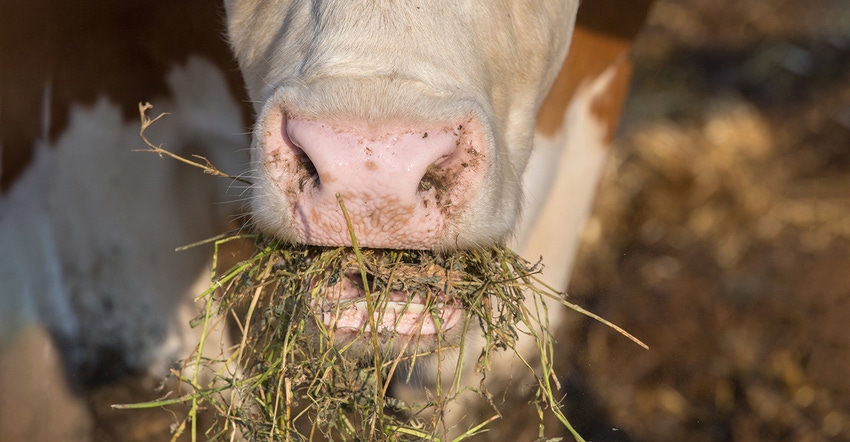
Two years of abnormal weather changed plant growth, which changes livestock digestion. In the end, cows die.
The words “it’s very complex” kept popping up in a University of Missouri emergency teleconference of state and regional MU Extension specialists in early March.
This winter, farmers found groups of cows dead, the animals often falling on newly unrolled baled hay. In the worst cases, half the herd died. For many, the first sign of trouble was 10 dead cows.
The MU Veterinary Medical Diagnostic Laboratory in Columbia has diagnosed more than 200 deaths from nitrate poisoning in the past month. The lab’s toxicology section head, Tim Evans, said it first: “It’s very complex.”
A bit later, MU Extension beef nutritionist Eric Bailey told of first aid to help nitrate-stricken cattle. Feed shelled corn to cows normally fed hay. “It’s very complex,” he adds.
Toxic scenario
Unusual weather the past couple of years set up this problem. Too much rain turned to too much drought. Hot weather turned very cold. Such extremes affect the biology of plant growth. Also, lots of pastures didn’t grow. That led to the hay shortages.
Fertilizer and poultry litter make grass grow. Nitrogen enters the plant as nitrate. That adds growth and protein for hay fed to cattle. Nitrogen fuels a cow’s rumen, the first stomach in digestion. In the end, nitrogen creates protein, making meat. Normally, more nitrogen on hayfields helps. More protein-rich hay grows healthy cattle.
When rains turn to drought, biology stops working. When plant juices stop flowing from roots to leaves, the raw nitrate stays in grass stems. When farmers bale nitrate-rich grass, the hay turns toxic.
What is normally a good practice of fertilizing grass becomes a bad practice. Who knew? As specialists said, “It’s very complex.” Many variables come into play.
Cause of death
The cow rumen needs nitrates to digest hay and make protein. Too much nitrate in hay stems overwhelms the digestive system. Toxins spill over into the blood.
This is where it gets more complex. An oversupply of nitrate ends up as nitrite. Nitrites prevent oxygen from binding with red blood cells. Without oxygen, animals die. That’s how nitrate-rich hay kills cows quickly.
All a farmer sees of that complexity are dead cows beside hay just unrolled.
Add corn
Bailey spoke up with a fix. Adding starch to the cow’s diet absorbs much of that extra nitrate in the rumen. Normally, farmers are advised to go slow adding corn to a rumen on a hay diet. At first, starch upsets rumen microbes.
In this unusual year, plain corn gives an answer. But adding a protein-rich supplement worsens the problem. Protein adds unneeded nitrogen. At first sign of trouble, take away any protein supplement.
Corn, a starch, speeds up digestion in the rumen. That moves toxic hay down the digestive tract.
At first sign of nitrate poisoning, which often can be death, remove bad hay.
Test hay
As a first step, farmers should test suspect hay for nitrates, says Craig Roberts, MU Extension forage specialist.
“Know your hay,” Roberts said. Know where it came from and whether fertilizer or poultry manure was used. Risks rise in hay made in drought. Hay detective work doesn’t come easy.
Farmers now face a serious problem. After two years of drought, not much hay was baled. Buying good hay becomes almost impossible. It’s hard to find.
County MU Extension centers may have quick-test kits left over from last summer’s droughts. A few drops of the acid turn dark blue on split stems of high-nitrate grass.
Blue indicates a quantitative test is needed.
Evans says quantitative nitrate tests report parts per million. Less than 2,500 ppm seems safe. More than 5,000 ppm means danger. At 10,000, watch out.
Monitor cows
Evans says added problems come when cold fronts descend from the Arctic. Cattle sense weather changes in advance, and then they overeat, filling the rumen with forage for the cold spell. Even borderline toxic hay not causing trouble becomes potentially toxic in an overloaded rumen.
Pregnant cows near calving are vulnerable. Unborn calves die of nitrate poison. They lack oxygen.
Cows in poor condition suffer most. With low hay supplies and bad weather, cows started winter in lower body condition. Thin cows with less fat reserves are more vulnerable.
Roberts says toxin management includes watching each cow. Some may show early signs of poisoning by their weakness. That warns of complex problems ahead.
Ask for help from veterinarians or Extension specialists early rather than later.
The MU Extension guide “Nitrate Problems in Livestock Feed and Water” is available for free download at extension.missouri.edu/p/g9800.
Dailey is a retired emeritus professor with the University of Missouri. He writes from Columbia, Mo.
About the Author(s)
You May Also Like




